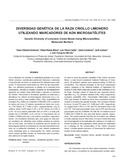Diversidad genética de la raza criollo limonero utilizando marcadores de ADN microsatélites
Date
2008-10-20Author
Palabras Clave
Criollo limonero, Variabilidad genética, MicrosatélitesCriollo limonero breed, Genetic diversity, Microsatellite
Metadata
Show full item recordAbstract
Con la finalidad de estudiar la variabilidad genética de la raza Criollo Limonero considerada patrimonio Nacional y orientada
a la producción de leche, se analizaron 95 animales puros utilizando 14 marcadores moleculares de ADN del tipo microsatélites. Los animales pertenecen al rebaño de la estación local Carrasquero, adscrita al Instituto Nacional de Investigaciones Agrñicolas del Estado Zulia (INIA-Zulia) y ubicado al noroeste del Estado. Para medir la diversidad genética se estimaron y discutieron los valores de heterocigosis observada (Ho) y esperada (He) total y entre familias (HMo, HMe), probabilidad de exclusión (Pe), Índice de Contenido Polimórfico (PIC) y número de alelos por locus. El número promedio de alelos por locus, He y PIC fueron: 8,7; 0,689 y 0,651, respecitvamente. Las He variaron desde 0,355 hasta 0,787 y el PIC fluctuó de 0,301 a 0,757. El locus menos polimófico fué el ILST5 y el más polimófico fue el CSSM66. La Pe con los 14 marcadores fue de 0,9962 y 0,9999 para uno y dos padres conocidos, rspectivamente. Los resultados indicaron que este grupo de marcadores resultaron ser eficientes para realizar pruebas de paternidad en esta raza, así mismo se muestran que los niveles de heterosigosis indican la existencia de una alta diversidad molecular en la población estudiada, la cual deberá mantenerse como estrategia para la conservación del Criollo Limonero como recurso genético bovino de Venezuela para la producción animal en la región tropical.
Collections
Información Adicional
| Otros Títulos | Genetic diversity of limonero creole breed using microsatellites molecular markers |
| Correo Electrónico | jaaranguren@luz.edu.ve |
| Resumen en otro Idioma | In order to study the genetic variability of the Criollo Limonero Breed, a dairy breed considered National Patrimony of Venezuela, 95 purebred animals belonged to the local Carrasquero station, assigned to the National Institute of Agriculture Research of Zulia (INIA-Zulia) and located in the northwest of Zulia State. Average values of observed and expected heterocigocities (Ho, He), between families (HMo, HMe) respectively, exclusion probability (PE), Polymorphic Information Content (PIC) and number of alelles by locus were considered and discussed to measure the genetic diversity. The average of alleles by locus, He and PIC were: 8.7; 0.689 and 0.651, respectively. He ranged from 0.355 to 0.787 and PIC fluctuated from 0.302 to 0.757. The least polymorphic locus was ILST5 and the most polymorphic was the CSSM66. PE with the 14 markers was of 0.9962 and 0.9999 for one and both known parents, respectively. The results indicate that this set of markers are efficient to make paternity tests in this set of markers are efficient to make paternity tests in this breed, it is also evident that there are heterozigosity tests in this breed, it is also evident that there are heterozigosity levels indicating the existence of a high molecular diversity in this population, which should be maintained as a strategy for the conservation of the Criollo Limonero breed, a bovine genetic resource of Venezuela for animal production in the tropical regions. |
| Colación | 415-423 |
| País | Venezuela |
| Institución | Universidad del Zulia (LUZ) Universidad de Los Andes (ULA) |
| Publicación Electrónica | Revista Científica |
| Sección | Revista Científica: Salud Pública |






